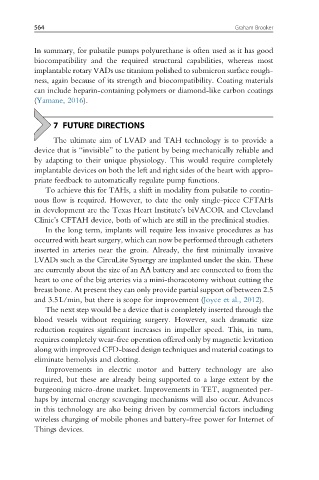Page 571 - Handbook of Biomechatronics
P. 571
564 Graham Brooker
In summary, for pulsatile pumps polyurethane is often used as it has good
biocompatibility and the required structural capabilities, whereas most
implantable rotary VADs use titanium polished to submicron surface rough-
ness, again because of its strength and biocompatibility. Coating materials
can include heparin-containing polymers or diamond-like carbon coatings
(Yamane, 2016).
7 FUTURE DIRECTIONS
The ultimate aim of LVAD and TAH technology is to provide a
device that is “invisible” to the patient by being mechanically reliable and
by adapting to their unique physiology. This would require completely
implantable devices on both the left and right sides of the heart with appro-
priate feedback to automatically regulate pump functions.
To achieve this for TAHs, a shift in modality from pulsatile to contin-
uous flow is required. However, to date the only single-piece CFTAHs
in development are the Texas Heart Institute’s biVACOR and Cleveland
Clinic’s CFTAH device, both of which are still in the preclinical studies.
In the long term, implants will require less invasive procedures as has
occurred with heart surgery, which can now be performed through catheters
inserted in arteries near the groin. Already, the first minimally invasive
LVADs such as the CircuLite Synergy are implanted under the skin. These
are currently about the size of an AA battery and are connected to from the
heart to one of the big arteries via a mini-thoracotomy without cutting the
breast bone. At present they can only provide partial support of between 2.5
and 3.5L/min, but there is scope for improvement (Joyce et al., 2012).
The next step would be a device that is completely inserted through the
blood vessels without requiring surgery. However, such dramatic size
reduction requires significant increases in impeller speed. This, in turn,
requires completely wear-free operation offered only by magnetic levitation
along with improved CFD-based design techniques and material coatings to
eliminate hemolysis and clotting.
Improvements in electric motor and battery technology are also
required, but these are already being supported to a large extent by the
burgeoning micro-drone market. Improvements in TET, augmented per-
haps by internal energy scavenging mechanisms will also occur. Advances
in this technology are also being driven by commercial factors including
wireless charging of mobile phones and battery-free power for Internet of
Things devices.

